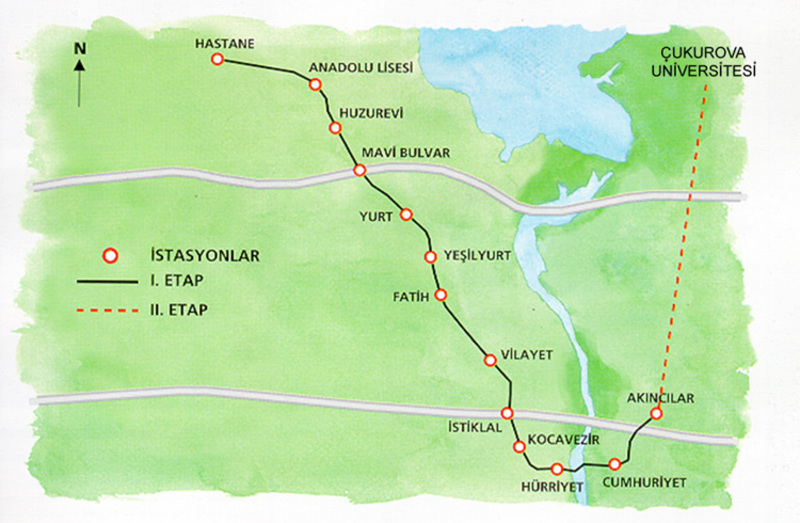The Adana Metro is an underground rail transport system located in Adana city, in southern Turkey. It a very recent metro system, being only inaugurated in 2010. It has only one operating line and 13 stations along a 13.5 km route. The Adana metrosu, as is it known in Turkish, is currently undergoing an expansion to the north of the city that will comprise seven new stations along a 9.3 km route, bringing the total up to 20 stations. It has a mix of underground, at-level and elevated viaducts. Service is provided from 6 a.m. to 11:30 p.m. Single fare tickets cost ₺2.75 lira (about $0.76 USD), but more offerings are available.
Metros of Turkey: Adana
Adana is a major city located to the south of the Republic of Turkey, and is the capital of the province of the same name. With about 2.1 million people living there, it is Turkey’s fifth largest city by population. It is very near the Mediterranean (about 30 km away from the coast), and is the most important settlement in the Cilicia region. The city is divided by the Seyhan river, and has a large industrial production. It specializes on textiles and food products.
Adana has a long history, being founded more than 3,000 years ago, and has had an important role throughout the centuries, from the Byzantine era in the 5th century (and whose roots are visible in the architecture all around the city) to modern day Turkey. The climate is very similar to the rest of the Mediterranean, with long hot summers and mild wet winters.
The Adana Metro system has a total length of 13.5 km route. It was fully inaugurated in 2010, after a series of tests held the year before on all 13 stations. An expansion is currently underway, and a new 9.3 km extension will link the existing track with 7 new stations. The metro is capable of transporting about 21,600 people every hour in each direction. The rolling stock is comprised of 36 Hyundai Euroterm LRVs, each one able to carry 311 passengers. Every train is made up of 3 wagons, so it can accommodate about 933 people while fully loaded. The entire trip along the line takes about 21 minutes in one direction. The metro is run and maintained by the Adana Metropolitan Municipality.
Short history
Although the system was founded in 2010, the original conception and planning of the system dates back 22 years, to 1988, after the Ministry of Transportation received requests from the Municipality and the Çukurova University. From 1990 to 1993, several partnerships were set up to run the project. It was not originally planned as a means to unify the northern and southern parts of the city, so the Municipality decided to modify the initial project. Works on the system officially began on January 28th, 1999.
Construction began without trouble but it swiftly overran its initial cost, forcing the local authorities to request more money from the central government. The loan was not authorized and construction was halted. It was not until 2008 that additional funds were granted and construction resumed. The metro opened its doors the following year for a testing period of three months, and passengers could ride free of charge between Hastane and Vilayet stations. It was then closed so construction could be finished. It was formally inaugurated in May of 2010 with all stations being fully operational.
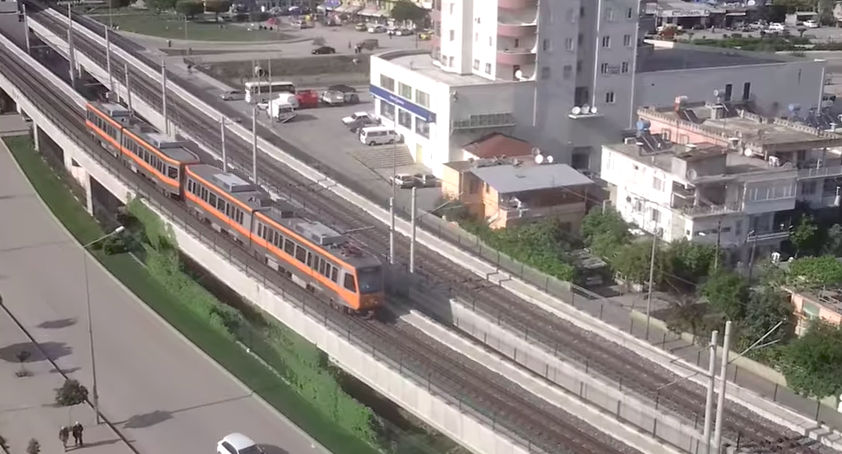
Stations
This metro has only one operational line that serves 13 stations that go through the city along a north-south axis. The journey begins at the maneuver patios and repair workshops of the system, near the Mental Health Hospital (Hastane station). The line continues east along the Turgut Özal boulevard to the Anadolu Lisesi station where it turns southeast along the Alparshan Türkeş boulevard, neat the city hall. It then turns east again after Kocavezir station, crosses the Seyhan river north of Regülatör bridge and then heads northeast to reach Akıncılar terminal station and the Yüreğir bus terminal.
The Adana Metro’s stations diverge on their level. They are as follow: Hastane (underground), Anadolu Lisesi (underground), Huzurevi (ground level), Mavi Bulvar (ground), Yurt (ground), Yeşilyurt (ground), Fatih (elevated), Vilayet (underground), İstiklal (underground), Kocavezir (elevated), Hürriyet (elevated), Cumhuriyet (elevated) and Akıncılar (elevated). All stations are equipped with mechanical stairs and elevators for people who need them. The platforms are wide and do not have security doors, so passengers must always be behind the yellow line for security reasons.
Connections to other systems
The Adana Metro is a small system, and although it connects a fair amount of the city, it lacks coverage (specially to residential areas). This is dealt with bus lines that cover the remaining areas, as in all big cities, but also with dolmuş, a smaller form of public transport that is popular in Turkey and northern Cyprus. These systems complement the metro and are available at all stations.
Local bus lines are also run by the Adana Transit Corporation. This government dependent institution organizes and covers the city via 229 buses that run in different lines all around the city. Rides can be payed for with the Kentkard travel card, the same one used in the metro system.
From Hastane station a bus line departs for Bahçeşehir - Carrefour - Adana Koop. From Anadolu Lisesi, buses cover the Seyhan Hospital – Kurttepe – Demirel boulevard. A little further down the line, at Yurt station, buses run to Barış Manço boulevard, PTT Road, Hayal Park, Mavi boulevard and Çetinkaya. From Fatih station, buses depart for Kıyıboyu Road, Cemalpaşa and Hastaneler.
Vilayet station is one of the most important stations of the system, as it connects to the Adana Station, the most important railway terminal within the city. Buses leave for Valilik, İstasyon Road, Tren Garı, Atatürk Road and Atatürk Park from this station as well. From Kocavezir station, buses depart for Bakım Yurdu Road, Kuruköprü, Küçüksaat, Saydam Road and Obalar Road. Finally, from Akıncılar station, the buses known as Kozan Yolu provide service through bus lines 110, 113, 114, 116, 118 and 126.
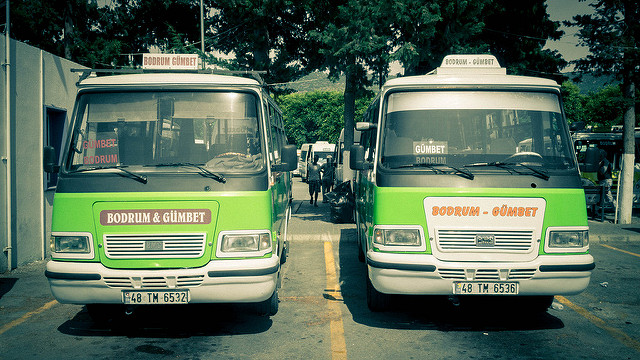
The other significant connection the metro has is with the dolmuş, an organized network of small buses and vans that serve as collective taxis. Tariffs are set and are independent of other public transport systems. There are 18 partnerships that run this service, providing the less reachable areas of the city with some sort of public transport. Only cash is allowed and passengers can choose where is it that they want to get off, they must only let the driver know with this phrase: Inecek Var! (someone will get off).
Connections to the airport
Currently, there are no direct connections between the Adana Metro and the Adana Şakirpaşa Airport (ADA), nor is the current expansion directed towards it. The main link between the two are buses that run from various stations to the airport.
The Adana Şakirpaşa Airport is the sixth most concurred airport in Turkey. Because of this, connection to and from the terminal is a necessity. The Adana Transit Corporation has two routes that run from the airport into the city. Route 135 connects it with Çukurova University, where it will meet a new metro station with the expansion of the current line.
The other bus line is route 159, and it stops in Kurttepe, in the central part of the city and close to Vilayet station. This is an important link in the system, as the Adana Station is also nearby. The airport itself has a railway connection, but line 159 has become the most important means of transport between the airport and the city. Buses depart every 35 minutes.
Schedule and timetables
The Adana Metro is open through most of the day. The first train departs from terminal station Akıncılar at 6:24 a.m. on weekdays. For the next 15 hours, trains depart every 10 minutes. It is not until 9:24 p.m., where the frequency is reduced and trains depart every 15 minutes until the last train at 11:24 p.m.
On weekends, these times vary slightly. The first train leaves Akıncılar at 6:39 a.m., while the last train does so at 11:24 p.m. On both, Saturday and Sunday, all trains leave every 15 minutes. For tourists, this information is especially useful so they can plan their agenda properly.
Tariffs, tickets and cards
In the Adana Metro, tariffs are fixed, so it doesn’t matter if you only travel between contiguous stations or decide to travel the entire line, prices will be the same. Single fare tickets cost ₺2.75 lira (about $0.76 USD). Round trip tickets go for ₺5.00 lira (about $1.38 USD). There is also a 4-trip ticket that costs ₺9.50 lira (about $2.61 USD).
The Adana metrosu also offers special pricing for students and certain groups. Students and professors have access to a special card that provides them with reduced pricing: ₺1.20 and ₺2.00, respectively for a single ticket (about $0.33 / $0.55 USD). A contactless card also exists, the Kenkart travel card. It can be used on the metro or bus lines, and costs ₺5.00 ($1.38 USD). All tickets are cheaper with this card, and it has the advantage that it can be easily recharged at any vending machine on any point of the system. It is also important to know that children below 6 years of age travel for free.
Rules and regulations
All public transport systems have rules that are intended to enforce the correct operation of the system and the safety of its users. The Adana Metro is no exception. The metro operators are the ones who enforce the rules. Some of them are as follow:
- Animals are not allowed on the metro unless they are small and travel in their cages. They must not be a nuisance to other passengers.
- Assistance animals (service dogs) for the disabled are the exception, as they are allowed.
- Inflammable or explosive objects, high pressure containers, biological waste, hazardous materials or any other object that may pose a risk are strictly forbidden. Weapons of all types are also forbidden, unless the user has a license for it.
- As with most other public transport systems, t is prohibited to smoke or consume alcoholic beverages within the facilities.
- All passengers must respect the yellow line on the platforms for their own safety, and must remain behind it at all times until the trains have come to a complete stop.
- Bicycles, wagons, skates or any other object with wheels are not allowed within the metro.
- All luggage or carry-ons must not be heavier than 15 kg and not be excessively large (100x50x60 cm).
- The elderly and people with reduced mobility or disabilities have priority over everyone else for the use of elevators located in any of the stations.
- It is forbidden to take photos or record video while inside the facilities.
- Food and drinks are not forbidden, but the metro operators constantly remind passengers to maintain the trains clean by putting the garbage in the container bins.
Future expansions
The Adana Metro has been a very positive change to the city, and the population at large supports it. It has been a huge success, but its small size is already a problem that could restrain the city’s future growth, despite having an expansion already in construction. This new extension will run to the northeast of the city, but on the eastern bank of the river. It will connect with Akıncılar station and continue along 6 other new stations until it reaches Çukurova University, to the northeast and near the Seyhan Dam.
This new segment will cover a length of 9.3 km, and add 7 new stations. The construction began in January 2010, when the initial contract was awarded. Once completed, it will bring the total system length up to 22.3 km and serve 20 stations. Apart from this, no further expansion is being considered at the moment. However, a complementary system has been proposed. It would use a light rail system along an existing railway as a suburban public transport that would link with the metro and to other railway stations that could provide connections to the certain areas of Turkey and the rest of Europe.
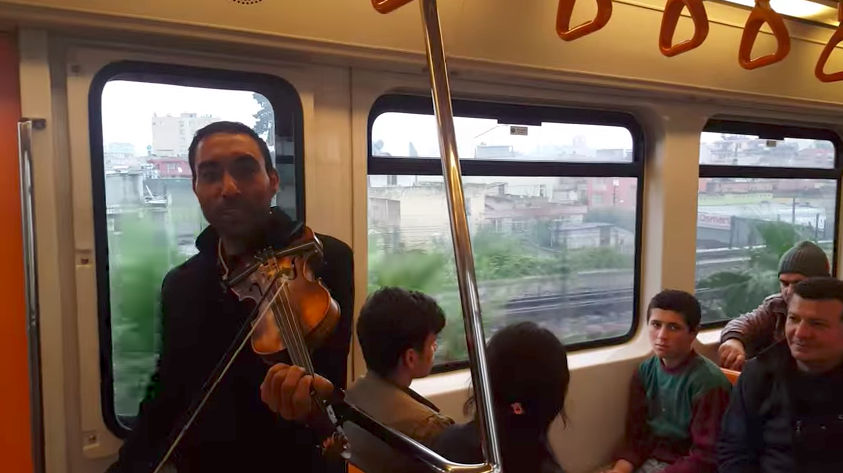
Tips and Advice
As with any other public transport, it is always important to keep an eye out for your belongings. Even though the Adana Metro has been classified as safe by many of its users and tourists, it is imperative to never lose contact with your things, especially if said things are valuable, such as personal documents or electronic devices.
If you are not familiar with the public transport systems within the city of Adana, it is best to seek guidance or information from the locals. This is especially true if you decide to (or must) travel in dolmuş, as that is a rather informal system that could prove complicated to handle for tourists. The metro and buses are friendlier in this regard, with visible signs and other visual aids, as well as defined stops.
As with all touristic trips on a foreign country, it is also advisable to get to know a little bit about traditions and cultural references, as well as to plan the trip beforehand, as English signs are quite rare, so you must either know the station or be able to read Turkish in order to successfully navigate the system with ease.
On another note, it is important to not lose sight of luggage, as it may attract undesired attention from operators or passengers and may even cause a security issue.
Fun facts and trivia
It is the most recent of the metro systems in the Republic of Turkey, being opened to the public in 2010. The other mass transport systems in the country are in Ankara, Bursa, Istanbul and Izmir.
It took 22 years from the moment the project received authorization to begin, to the metro’s official inauguration in 2010, this mainly due to changes to the original proposal and financing difficulties.
In the year 2002, development was halted due to insufficient funds, and it was not until 2008 that the construction resumed.
The Adana Metro combines three types of stations: underground, level and elevated stations, so the architecture of the system is varied and well-elaborated.
The Adana metrosu logo is an opaque orange diamond with a white curved ‘M’ in the middle.
Sightseeing
The city of Adana is not the most populous nor the most visited of the Turkish cities, but like many of the other major cities in Turkey, it does have many tourist attractions that make it a desirable destination. The metro allows for the quick transit through the city, so it is certainly a good way to get around. Since it crosses the city in a north-south axis, it services many districts. Some of the most notable attractions that are easily reached via the metro are:
- Atatürk Park: this is one of the most famous parks within the city, and is named after the founding father of the modern-day Republic of Turkey. It is located in the central part of the city, and it has become a true urban oasis due to the amount of plants and trees that it has. It is a few blocks away from Vilayet station.
- Sabanci Central Mosque: this is the largest mosque in Turkey, and one of its most visited places. It has 6 minarets that are high enough to be visible from most parts of the city and an astonishing architecture of the main building. This mosque is both a site for religious pilgrimage and a tourist attraction. It is located in Merkez Park, on the western bank of the river, near the central part of the city. It is reachable through Vilayet station.
Another Adana MetroSu Map
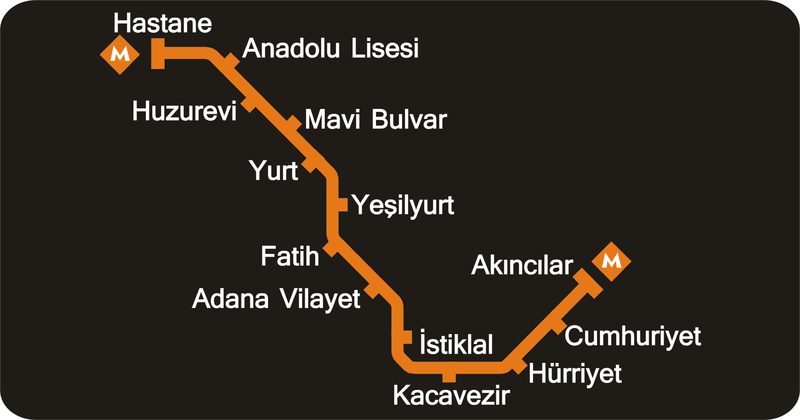 Source Wikipedia CC Share Alike
Source Wikipedia CC Share Alike
Adana Adana metrosu map
- Also Known As: Adana metrosu
- Passengers/Day 660000
- Fares:
- 24h operation: No
- Air Conditioning: No
- Walk between platforms: No
- Driverless trains: No
- Screen Doors Platforms: No
- Average Speed: km/h
- Max. Speed: 80 km/h
- Operator: Adana Metropolitan Municipality
- 2.00 TL
- Adana Metro Official Website
Help us
If you consider that the information we provide is wrong, not accurated, outdated, translation contains errors, and you would like to help us to improve the file...you can contact us here.
Feel free to contact us if you dont find the system you're looking for and we'll add it as soon as we can!
Thank you very much!







